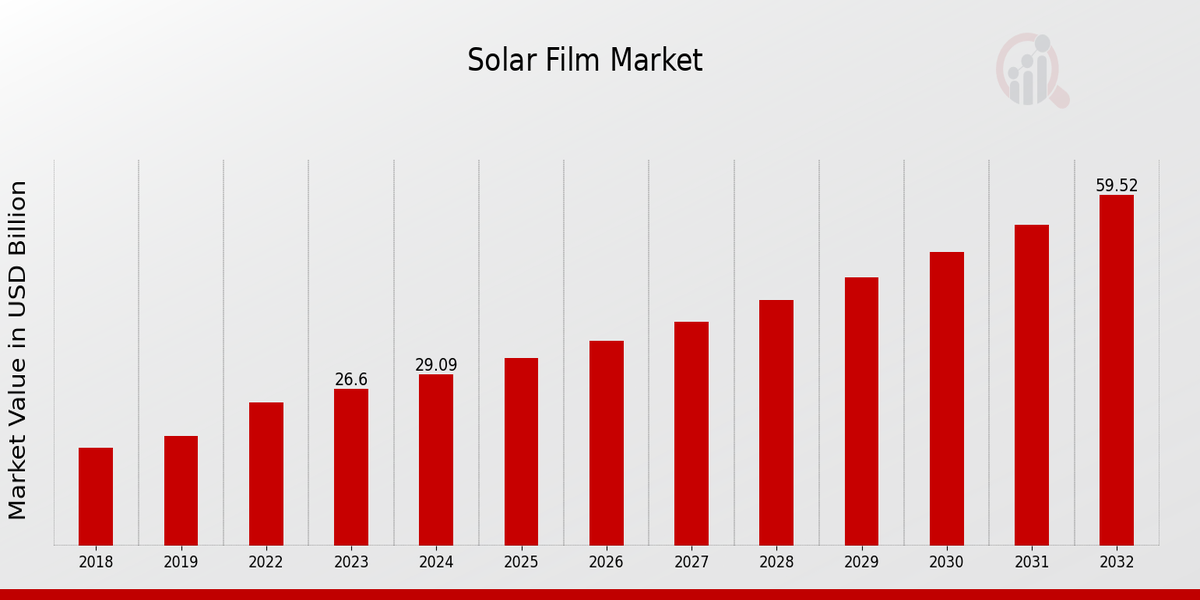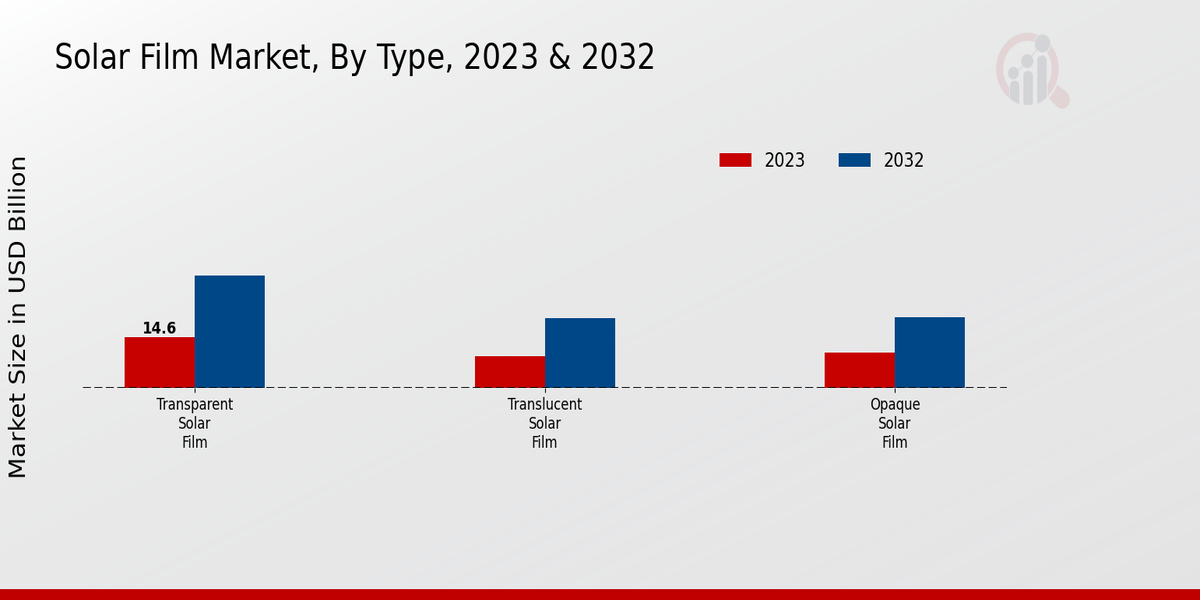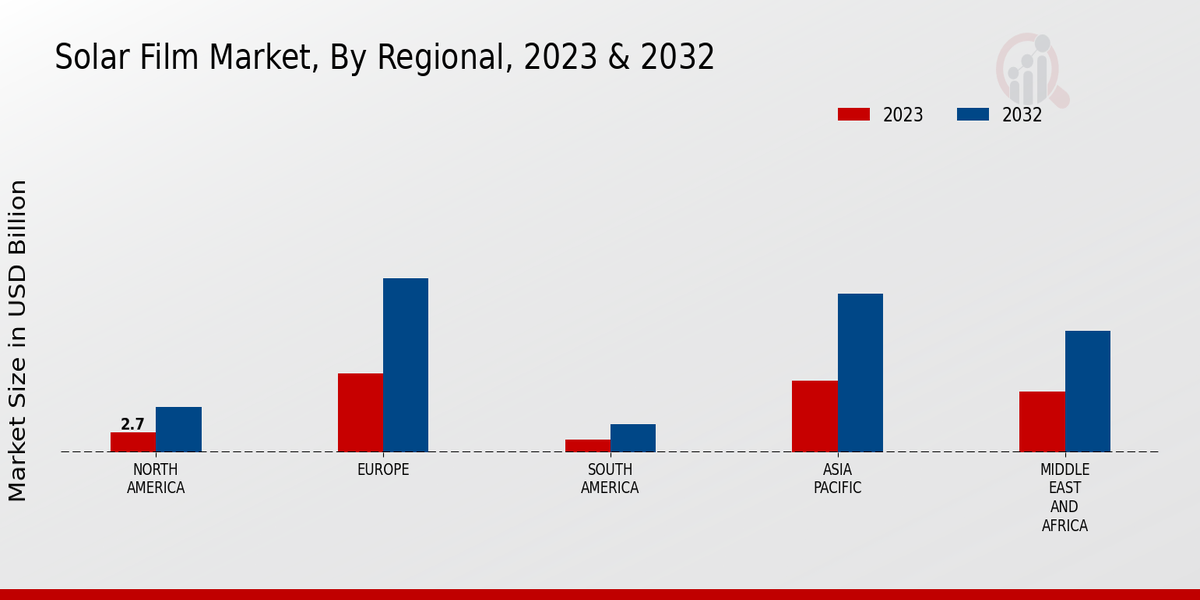Global Solar Film Market Overview
As per MRFR analysis, the Solar Film Market Size was estimated at 31.82 (USD Billion) in 2024. The Solar Film Market Industry is expected to grow from 34.80 (USD Billion) in 2025 to 77.88 (USD Billion) till 2034, at a CAGR (growth rate) is expected to be around 9.36% during the forecast period (2025 - 2034).
Key Solar Film Market Trends Highlighted
One of the key market drivers for the development of the solar film industry is rising awareness of climate change and the necessity of energy conservation. Several nations have adopted favorable measures such as tax rebates and Feed-in Tariff plans in order to push for solar film usage. Besides, there have been developments in technology that improve the efficacy and cost-effectiveness of solar films for consumers. New entrants in the solar film market are encouraged to reach out to the untapped regions with high solar potential. Actors in the industry, including manufacturers, installers and researchers, need to work with each other, as it would help improve creativity and lower expenses. The emergence of smart cities and solar films incorporated into building facades is another channel for the growth of the market. The latest trends prevailing in the solar film market are rolled out thin-film technologies taking advantage of the flexibility and low materials compared to the traditional crystalline panels. In addition, new possibilities for glass surfaces, e. g., windows or skylights in buildings, have been opened by increasing the potential of clear solar films. It is also noted that there is a trend towards adding features for the most demanding aesthetics in solar film products due to the increasing desire for solar strategies that are beautiful.

Source: Primary Research, Secondary Research, MRFR Database and Analyst Review
Solar Film Market Drivers
Increasing Demand for Renewable Energy
The growing awareness of the environmental impact of fossil fuels and the need to transition to renewable energy sources is a major driver of the Solar Film Market Industry. Governments worldwide are implementing policies and incentives to promote the adoption of solar energy, which is leading to increased demand for solar film. Solar film is a thin, lightweight material that can be applied to windows or other surfaces to convert sunlight into electricity.It is a versatile and cost-effective way to generate renewable energy, and its popularity is expected to continue to grow as the world moves towards a more sustainable future.
Technological Advancements
The Solar Film Market Industry is also being driven by technological advancements that are improving the efficiency and affordability of solar film. Researchers are developing new materials and manufacturing processes that are making solar film more efficient at converting sunlight into electricity. In addition, the cost of solar film is declining, making it more accessible to consumers and businesses.
Government Support
Government support is another key driver of the Solar Film Market Industry. Governments around the world are implementing policies and incentives to promote the adoption of solar energy. These policies include tax breaks, rebates, and feed-in tariffs. Government support is helping to make solar film more affordable and accessible to consumers and businesses, which is leading to increased demand for solar film.
Solar Film Market Segment Insights
Solar Film Market Type Insights
The Solar Film Market is segmented by type into transparent solar film, translucent solar film, and opaque solar film. In 2023, the transparent solar film segment accounted for the largest market share, and it is expected to continue to dominate the market over the forecast period. The growth of this segment can be attributed to the increasing demand for transparent solar films for use in building integrated photovoltaic (BIPV) applications. BIPV systems are becoming increasingly popular as they offer a number of benefits, such as reduced energy costs, improved aesthetics, and increased energy efficiency.The translucent solar film segment is expected to witness the highest growth rate over the forecast period. This growth can be attributed to the increasing demand for translucent solar films for use in greenhouses and agricultural applications. Translucent solar films allow light to pass through while still generating electricity, which makes them ideal for use in these applications. The opaque solar film segment is expected to account for a significant market share over the forecast period. This growth can be attributed to the increasing demand for opaque solar films for use in commercial and industrial applications.This growth can be attributed to the increasing demand for solar films for use in a variety of applications, including BIPV, greenhouses, agricultural applications, commercial applications, and industrial applications.

Source: Primary Research, Secondary Research, MRFR Database and Analyst Review
Solar Film Market Substrate Material Insights
The substrate material is a key component of solar films, influencing their performance, cost, and applications. The Solar Film Market is segmented into three primary substrate materials: Glass is the traditional substrate material for solar films, offering high transparency, durability, and thermal stability. However, glass is relatively heavy and expensive, limiting its use in lightweight and flexible applications. Polymer substrates are lightweight, flexible, and cost-effective, making them suitable for use in portable and wearable devices.However, polymers exhibit lower optical clarity and thermal stability compared to glass. Metal substrates provide high electrical conductivity and thermal stability, but they are opaque and more expensive than glass or polymer substrates. The choice of substrate material depends on the specific application requirements. Glass substrates dominate the market for large-scale solar installations, while polymer and metal substrates are gaining traction in emerging applications such as building-integrated photovoltaics and portable electronics.
Solar Film Market Application Insights
The Solar Film Market segmentation by Application is classified into Windows Skylights, Building Facades, Automotive, and Consumer Electronics. Windows Skylights segment accounted for a substantial share of the market in 2023, owing to the rising demand for energy-efficient solutions in residential and commercial buildings. The Building Facades segment is projected to witness significant growth during the forecast period, driven by the increasing adoption of solar films in commercial buildings to reduce energy consumption and improve aesthetics.The automotive segment is expected to gain traction due to the growing demand for solar films in electric and hybrid vehicles to extend battery life and enhance passenger comfort. The consumer Electronics segment is anticipated to contribute to the market growth, driven by the integration of solar films in portable electronic devices to enhance battery life and reduce glare.
Solar Film Market Efficiency Range Insights
The Solar Film Market exhibits significant variation in terms of efficiency range, with different segments catering to specific application requirements. The ' 5%' efficiency range held a considerable market share in 2023, owing to its cost-effectiveness and suitability for low-power applications. However, the '5-10%' and '10-15%' efficiency ranges are projected to witness substantial growth in the coming years, driven by increasing demand for higher-efficiency solar panels in both residential and commercial sectors. Notably, the '> 15%' efficiency range is expected to gain prominence in the long term, as technological advancements enable the production of high-performance solar films with improved conversion rates.This segment is anticipated to capture a significant market share by 2032, driven by the growing adoption of solar energy in large-scale power generation projects.
Solar Film Market Power Output Insights
The power output segment plays a crucial role in shaping the dynamics of the Solar Film Market. Categorized into four sub-segments - ' 50 W', '50-100 W', '100-200 W', and '> 200 W' - each segment caters to specific application requirements and contributes to the overall market growth. In 2023, the ' 50 W' segment held a significant market share due to its widespread adoption in portable and off-grid systems. The '50-100 W' segment is expected to witness steady growth, driven by increasing demand for residential and commercial installations.The '100-200 W' segment is projected to expand rapidly, fueled by the growing adoption of solar films in large-scale projects and industrial applications. The '> 200 W' segment is anticipated to gain traction in the coming years, driven by advancements in solar cell technology and the need for high-efficiency energy solutions. The Solar Film Market is expected to reach a valuation of 29.3 billion USD by 2027, expanding at a CAGR of 10.2%. This growth is attributed to the increasing demand for renewable energy sources, government incentives, and technological advancements.The power output segment is expected to continue playing a pivotal role in driving market expansion, with each sub-segment contributing to the overall market revenue and shaping the competitive landscape.
Solar Film Market Regional Insights
The regional segmentation of the Solar Film Market provides insights into the market's geographic distribution and growth dynamics. North America held the largest market share in 2023 due to factors such as government incentives, technological advancements, and the presence of key industry players. Europe is projected to experience significant growth over the forecast period, driven by the increasing adoption of solar energy and favorable regulatory policies. APAC is expected to emerge as a key growth region, with China and India being the major contributors.South America and MEA are anticipated to witness steady growth, with the rising demand for solar energy in emerging markets.

Source: Primary Research, Secondary Research, MRFR Database and Analyst Review
Solar Film Market Key Players And Competitive Insights:
Major players in the Solar Film Market industry are constantly innovating new technologies and expanding their product portfolio to cater to the growing demand. Leading Solar Film Market players are focusing on developing cost-effective and high-performance solar films to gain a competitive edge. The Solar Film Market development is driven by the increasing adoption of solar energy solutions and government initiatives to promote renewable energy sources. The competitive landscape is expected to intensify further with the entry of new players and the expansion of existing players into new markets.3M is a leading player in the Solar Film Market. The company offers a wide range of solar films for various applications, including window films, automotive films, and building films. 3M's solar films are known for their high performance, durability, and aesthetic appeal. The company has a strong distribution network and a global presence, which enables it to cater to the needs of customers worldwide.Hanita Coatings is a major competitor in the Solar Film Market. The company specializes in the production of high-performance solar films for the automotive and architectural industries. Hanita Coatings' solar films are known for their exceptional heat rejection, glare reduction, and UV protection capabilities. The company has a strong focus on research and development, and it continuously invests in new technologies to improve the performance and functionality of its solar films.
Key Companies in the Solar Film Market Include:
- JX Nippon Chemical Plastics Corporation
- Eastman Kodak Company
- Kolon Industries, Inc.
- SABIC
- Hanwha Chemical Corporation
- Toray Industries, Inc.
- Mitsubishi Chemical Corporation
- Sumitomo Chemical Company, Limited
- Eastman Chemical Company
- LG Chem, Ltd.
- SaintGobain
- Covestro AG
- Samsung SDI
- DuPont Teijin Films
- 3M Company
Solar Film Market Industry Developments
The Solar Film Market is projected to grow from an estimated USD 34.80 billion in 2025 to USD 77.88 billion by 2034, exhibiting a CAGR of 9.36%. This growth is attributed to increasing demand for renewable energy sources, rising environmental concerns, and government initiatives promoting solar energy adoption.Recent news developments in the market include the launch of new high-efficiency solar films by major manufacturers like 3M and Avery Dennison. These films offer improved light transmission and durability, making them suitable for various applications, including commercial buildings, residential homes, and vehicles.Key market players are focusing on research and development to enhance the performance and cost-effectiveness of solar films. Strategic partnerships and acquisitions are also prevalent as companies seek to expand their market reach and product portfolio. The increasing adoption of solar films in emerging economies, coupled with technological advancements, is expected to drive market growth in the coming years.
Solar Film Market Segmentation Insights
-
Solar Film Market Type Outlook
- Transparent Solar Film
- Translucent Solar Film
- Opaque Solar Film
-
Solar Film Market Substrate Material Outlook
-
Solar Film Market Application Outlook
- Windows Skylights
- Building Facades
- Automotive
- Consumer Electronics
-
Solar Film Market Efficiency Range Outlook
-
Solar Film Market Power Output Outlook
- 50 W
- 50-100 W
- 100-200 W
- > 200 W
-
Solar Film Market Regional Outlook
- North America
- Europe
- South America
- Asia Pacific
- Middle East and Africa
| Report Attribute/Metric |
Details |
|
Market Size 2024
|
31.82 (USD Billion)
|
|
Market Size 2025
|
34.80 (USD Billion)
|
|
Market Size 2034
|
77.88 (USD Billion)
|
|
Compound Annual Growth Rate (CAGR)
|
9.36% (2025 - 2034)
|
|
Report Coverage
|
Revenue Forecast, Competitive Landscape, Growth Factors, and Trends
|
|
Base Year
|
2024
|
|
Market Forecast Period
|
2025 - 2034
|
|
Historical Data
|
2019 - 2023
|
| Market Forecast Units |
USD Billion |
| Key Companies Profiled |
JX Nippon Chemical Plastics Corporation, Eastman Kodak Company, Kolon Industries, Inc., SABIC, Hanwha Chemical Corporation, Toray Industries, Inc., Mitsubishi Chemical Corporation, Sumitomo Chemical Company, Limited, Eastman Chemical Company, LG Chem, Ltd., SaintGobain, Covestro AG, Samsung SDI, DuPont Teijin Films, 3M Company |
| Segments Covered |
Type, Substrate Material, Application, Efficiency Range, Power Output, Regional |
| Key Market Opportunities |
Rising consumer awareness of technological advancements, government incentives, growing demand for energy efficiency, expanding architectural applications |
| Key Market Dynamics |
Increasing government incentives for technological advancements, rising energy costs, growing demand for renewable energy and expanding solar energy installations |
| Countries Covered |
North America, Europe, APAC, South America, MEA |
Frequently Asked Questions (FAQ) :
The Solar Film Market is expected to reach USD 34.80 billion in 2025.
The Solar Film Market is expected to grow at a CAGR of 9.36% from 2025 to 2034.
The North America region is expected to dominate the Solar Film Market in 2023.
Key applications of Solar Film include building integrated photovoltaics (BIPV), portable solar chargers, and solar carports.
Key competitors in the Solar Film Market include 3M, DuPont, Hanwha SolarOne, and Saint-Gobain.
The Solar Film Market is expected to reach USD 59.5 billion by 2032.
Key growth drivers of the Solar Film Market include increasing demand for renewable energy, rising adoption of BIPV, and government initiatives promoting solar energy.
Challenges faced by the Solar Film Market include high manufacturing costs, limited efficiency, and competition from other renewable energy technologies.
Key trends in the Solar Film Market include the development of new materials, advancements in printing technology, and the integration of solar film with other building materials.
The Solar Film Market is expected to have a positive impact on the environment by reducing greenhouse gas emissions and promoting the use of renewable energy.

















